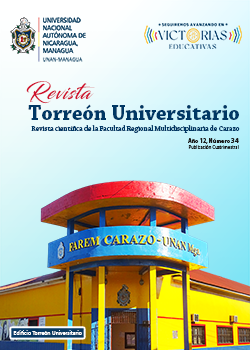Evaluation of variables of vegetative growth of amaranth (Amaranthus cruentus L.) variety Amaranteca in the Biotechnology Laboratory, National Autonomous University of Nicaragua, Managua
DOI:
https://doi.org/10.5377/rtu.v12i34.16379Keywords:
Amaranth, Vegetative growth, UNAN ManaguaAbstract
The objective of this study was to evaluate the vegetative growth variables of Amaranthus cruentus L. var. Amaranteca in Managua. The cultivation was established during the months of June-September 2010, on a property located in the Ricardo Morales Avilés University Campus - UNAN Managua, the experimental unit consisted of five rows of 50 m long, with distance between plants and rows of 50 cm, 100 kg ha-1 was fertilized with NPK (12-30-10). A direct stream sowing system was used, the emergence of seedlings occurred after four days, thinning, weed control and hilling were carried out. The maximum averages in the variables were 255 cm in Height of the plant, 109 units of leaves, 29.8 cm in Length of leaf and 4.2 cm in Diameter of the stem. Significant differences (Tukey, p> 0.05) were found between Height of the plant and Number of leaves; Stem diameter and number of leaves; and Stem diameter and size of leaves.
Downloads
References
Barba de la Rosa, A. P., Fomsgaard, I. S., Laursen, B., Mortensen, A. G., Olvera-Martínez, L., Silva-Sánchez, C., … De
León-Rodríguez, A. (2009). Amaranth (Amaranthus hypochondriacus) as an alternative crop for sustainable
food production: Phenolic acids and flavonoids with potential impact on its nutraceutical quality. Journal of
Cereal Science, 49(1), 117–121. https://doi.org/10.1016/j.jcs.2008.07.012
Comisión de Agricultura, Ganadería, Pesca y Desarrollo rural. (2019). Iniciativa con proyecto de decreto por lo que
se adiciona una fracción XII al artículo 179 de la ley de desarrollo rural sustentable, para considerar al amaranto
como producto básico y estratégico. Estados Unidos Mexicanos.
Dirección General de Meteorología. (2008). Caracterización Climática del Departamento de Managua. Instituto
Nicaraguense de Estudios Territoriales (INETER).
García Ibarra, L. (2012). Variedades de Amaranto y fechas de siembra para rendimiento de grano y forraje en San
Luis Potosí. Tesis profesional presentada como requisito parcial para obtener el título de Ingeniera Agrónoma
Fitotecnista, Universidad Autónoma de San Luis Potosí, Facultad de Agronomía.
García Pereyra, J., Valdés Lozano, C. G., Olivares Sáenz, E., Alvarado Gómez, O., Alejandré Iturbide, G., Salazar Soza,
E., & Medrano Roldán, H. (2009). Rendimiento de grano y calidad del forraje de Amaranto (Amaranthus spp.)
cultivado a diferentes densidades en el noreste de México.
Guaman Yupa, S. M. (2012). "Evaluación del potencial de rendimiento de una variedad y dos líneas de amaranto
(Amaranthus spp.) en dos sistemas de siembra, manual y mecánico en el Cantón El Tambo provincia del Cañar".
Tesis para obtener título de Ingeniería Agronómica, Riobamba-Ecuador.
López, A., & Alonso, J. A. (2019). e return of Amaranthus spp. as a potential crop for human nutrition. Rd-Icuap.
Luis, G. M., Hernández Hernández, B. R., Peña Caballero, V., Torres López, N. G., Espinoza Martínez, V. A., &
Ramírez Pacheco, L. (2018). Usos actuales y potenciales del Amaranto (Amaranthus spp.). Journal of Negative
and No Positive Results, 3(6), 423-436.
Monsalvo Jiménez, C., & Oliver Guadarrama, R. (2004). Producción de Amaranto (Amaranthus hypocondriacus L.)
a tres fechas de siembra en Huazulco, Temoac, Morelos. 10.
Olán, M. D., Espitia Rangel, E., Ayala Garay, A. V., Hernández Casillas, J. M., Arellano Vázquez, J. L., & Ruiz
Hernández, V. C. (2012). Caracterización morfológica de germoplasma para grano de amaranto (Amaranthus
spp.). En E. Espitia Rangel, & E. Espitia Rangel (Ed.), Amaranto: Ciencia y Tecnología. Libro Científico No. 2.
INIFAP/SINAREFI. (Primera ed., págs. 165-181). México.
Paredes López, O., & Hernández López, D. (1992). Food Properties of Amaranth Seeds and Methods for Starch
Isolation and Characterization. En Linskens, H.F., Jackson, J.F. (eds) Seed Analysis (Vol. 14, págs. 217–239).
doi:https://doi.org/10.1007/978-3-662-01639-8_11
Svirskis, A. (2003). Investigation of amaranth cultivation and utilisation in Lithuania. Agronomy Research, 1(2), 253–
Obtenido de https://www.doc-developpement-durable.org/file/Culture/Culture-plantes-alimentaires/
FICHES_PLANTES/amarante/testing%20amaranth%20in%20Lithuania.pdf
Zelaya Morales, M. Y. (2015). Evaluación agronómica de la variedad adaptada de amaranto (Amaranthus spp) bajo
las condiciones climáticas en el Centro de Desarrollo Tecnológico CDT-INTA San Isidro, del departamento
de Matagalpa, año 2015. Monografía para optar al Título de Ingeniería Agronómica, Universidad Nacional
Autónoma de Nicaragua, Managua. FAREM Matagalpa.
Downloads
Published
Issue
Section
License
Copyright (c) 2023 National Autonomous University of Nicaragua, Managua

This work is licensed under a Creative Commons Attribution-NonCommercial-NoDerivatives 4.0 International License.
The authors who publish in this journal agree to the following terms.
- The author or authors of the articles, essays or research grant the National Autonomous University of Nicaragua, Managua (UNAN-Managua) the editing rights (copyright) of the submitted work, therefore the University has the exclusive right to publish the article for the entire copyright period.
- These copyrights/authors authorize Torreón Universitario Magazine and the University to edit and disseminate/publish the article in said Magazine, including printed and electronic reproduction, storage, retrieval and any other type of publication, and sources of secondary information as services. of summaries and databases, they also empower it to protect the article against unauthorized use for dissemination by printed or electronic media (PDF, HTML, EPUB, XML or others).
License for use of content
The magazine uses the Creative Commons Attribution-NonCommercial-NoDerivs 4.0 International License.
Under this statement:

This journal is licensed under a Creative Commons Attribution-NonCommercial-NoDerivatives 4.0 International License. It can be copied, distributed and transmitted publicly as long as the author and source are cited (Revista Torreón Universitario), it should not be modified or used for any commercial purpose. The full license can be found at http://creativecommons.org/licenses/by-nc-nd/4.0/.



